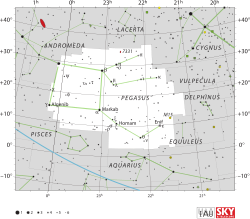Mu Pegasi
| Observation data Epoch J2000.0 Equinox J2000.0 | |
|---|---|
| Constellation | Pegasus |
| Right ascension | 22h 50m 00.19315s[1] |
| Declination | +24° 36′ 05.6984″[1] |
| Apparent magnitude (V) | 3.514[2] |
| Characteristics | |
| Spectral type | G8 III[3] |
| U−B color index | +0.674[2] |
| B−V color index | +0.932[2] |
| Astrometry | |
| Radial velocity (Rv) | +13.54 ± 0.20[4] km/s |
| Proper motion (μ) | RA: +144.70[1] mas/yr Dec.: –41.87[1] mas/yr |
| Parallax (π) | 30.74 ± 0.27 mas[1] |
| Distance | 106.1 ± 0.9 ly (32.5 ± 0.3 pc) |
| Absolute magnitude (MV) | +0.432[5] |
| Details | |
| Mass | 2.7[5] M☉ |
| Radius | 9.6 ± 0.4[6] R☉ |
| Surface gravity (log g) | 2.50[3] cgs |
| Temperature | 4,950[3] K |
| Metallicity [Fe/H] | –0.03[3] dex |
| Rotational velocity (v sin i) | 4.0[7] km/s |
| Other designations | |
| Database references | |
| SIMBAD | data |
Mu Pegasi (μ Pegasi, abbreviated Mu Peg, μ Peg), formally named Sadalbari /ˌsædəlˈbɛəri/,[9] is a star in the northern constellation of Pegasus. The apparent visual magnitude of this star is 3.5,[2] which is bright enough to be seen with the naked eye even on a moonlit night. Based upon parallax measurements taken during the Hipparcos mission, it is approximately 106 light-years (32 parsecs) from the Sun.[1]
Nomenclature
μ Pegasi (Latinised to Mu Pegasi) is the star's Bayer designation.
It bore the traditional name Sadalbari, which derives from Template:Lang-ar saʿd al-bāriʿ, the “auspicious star of the splendid one.”[10] In 2016, the International Astronomical Union organized a Working Group on Star Names (WGSN)[11] to catalogue and standardize proper names for stars. The WGSN approved the name Sadalbari for this star on 21 August 2016 and it is now so included in the List of IAU-approved Star Names.[9]
In Chinese, 離宮 (Lì Gōng), meaning Resting Palace, refers to an asterism consisting of Mu Pegasi, Lambda Pegasi, Omicron Pegasi, Eta Pegasi, Tau Pegasi and Nu Pegasi.[12] Consequently, the Chinese name for Mu Pegasi itself is 離宮二 (Lì Gōng èr, "the Second Star of Resting Palace").[13]
Properties
The spectrum of this star matches a stellar classification of G8 III.[3] The luminosity class of 'III' means that it has exhausted the hydrogen fuel at its core and evolved into a giant star. It is slightly more massive than the Sun, but has expanded to nearly ten times the Sun's radius.[6] (Mishenina et al. (2006) list it with an estimated 2.7 times the mass of the Sun.[5]) The effective temperature of the outer atmosphere is about 4,950 K,[3] which is cooler than the Sun and gives it the yellow hue of a G-type star.[14][15] The abundance of elements other than hydrogen and helium, what astronomers term the metallicity, is similar to the abundance in the Sun.[3]
References
- ^ a b c d e f van Leeuwen, F. (November 2007), "Validation of the new Hipparcos reduction", Astronomy and Astrophysics, 474 (2): 653–664, arXiv:0708.1752, Bibcode:2007A&A...474..653V, doi:10.1051/0004-6361:20078357, S2CID 18759600
- ^ a b c d Jennens, P. A.; Helfer, H. L. (September 1975), "A new photometric metal abundance and luminosity calibration for field G and K giants.", Monthly Notices of the Royal Astronomical Society, 172 (3): 667–679, Bibcode:1975MNRAS.172..667J, doi:10.1093/mnras/172.3.667
- ^ a b c d e f g Frasca, A.; et al. (December 2009), "REM near-IR and optical photometric monitoring of pre-main sequence stars in Orion. Rotation periods and starspot parameters", Astronomy and Astrophysics, 508 (3): 1313–1330, arXiv:0911.0760, Bibcode:2009A&A...508.1313F, doi:10.1051/0004-6361/200913327, S2CID 118361131
- ^ Famaey, B.; et al. (January 2005), "Local kinematics of K and M giants from CORAVEL/Hipparcos/Tycho-2 data. Revisiting the concept of superclusters", Astronomy and Astrophysics, 430 (1): 165–186, arXiv:astro-ph/0409579, Bibcode:2005A&A...430..165F, doi:10.1051/0004-6361:20041272, S2CID 17804304
- ^ a b c Mishenina, T. V.; et al. (September 2006), "Elemental abundances in the atmosphere of clump giants", Astronomy and Astrophysics, 456 (3): 1109–1120, arXiv:astro-ph/0605615, Bibcode:2006A&A...456.1109M, doi:10.1051/0004-6361:20065141, S2CID 18764566
- ^ a b Nordgren, Tyler E.; et al. (December 1999), "Stellar Angular Diameters of Late-Type Giants and Supergiants Measured with the Navy Prototype Optical Interferometer", The Astronomical Journal, 118 (6): 3032–3038, Bibcode:1999AJ....118.3032N, doi:10.1086/301114
{{citation}}: CS1 maint: multiple names: authors list (link) - ^ Massarotti, Alessandro; et al. (January 2008), "Rotational and Radial Velocities for a Sample of 761 HIPPARCOS Giants and the Role of Binarity", The Astronomical Journal, 135 (1): 209–231, Bibcode:2008AJ....135..209M, doi:10.1088/0004-6256/135/1/209
- ^ "48 Peg -- High proper-motion Star", SIMBAD, Centre de Données astronomiques de Strasbourg, retrieved 2012-01-28
- ^ a b "Naming Stars". IAU.org. Retrieved 16 December 2017.
- ^ Allen, Richard Hinckley (1963) [1899]. Star Names: Their Lore and Meaning (rep. ed.). New York, NY: Dover Publications Inc. pp. 328–29. ISBN 0-486-21079-0.
- ^ IAU Working Group on Star Names (WGSN), International Astronomical Union, retrieved 22 May 2016.
- ^ (in Chinese) 中國星座神話, written by 陳久金. Published by 台灣書房出版有限公司, 2005, ISBN 978-986-7332-25-7.
- ^ (in Chinese) 香港太空館 - 研究資源 - 亮星中英對照表 Archived 2008-10-25 at the Wayback Machine, Hong Kong Space Museum. Accessed on line November 23, 2010.
- ^ "The Colour of Stars", Australia Telescope, Outreach and Education, Commonwealth Scientific and Industrial Research Organisation, December 21, 2004, archived from the original on March 10, 2012, retrieved 2012-01-16
- ^ Kaler, James B., "SADALBARI (Lambda and Mu Pegasi)", Stars, University of Illinois, retrieved 2012-01-28

